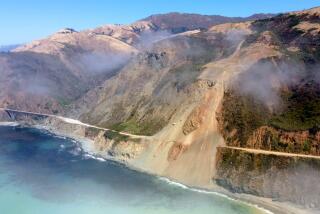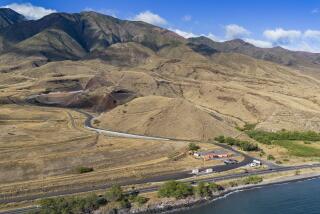On Hawaii Island, watching a disaster flow ever closer
- Share via
Reporting from Pahoa, Hawaii — It is 100 yards wide, nine miles long and traveling between 125 yards and 300 yards a day, a slow-moving ribbon of lava that has kept residents of the rural Puna district of Hawaii Island braced for the inevitable as the ongoing eruption of Kilauea volcano 10 miles away approaches.
If it stays on its current path, the lava would go through downtown Pahoa and cross Highway 130 — the only road linking the 9,000 residents of lower Puna with the rest of the island. About 7,000 vehicles travel the two-lane highway daily, and road crews have been feverishly working to finish alternate escape routes.
The flow began June 27 and traveled through an uninhabited rain forest, skirting the Ka’ohe Homesteads subdivision last week before slowing down. Hawaii County Civil Defense reports that the lava advanced only 70 yards on Thursday and is now stalled just above the colorful, historic village of Pahoa, population 945.
There has been no damage to structures, but no one in Puna operates under any illusions that the threat has passed; they know the flow could resume at any time. After all, this active volcano has been erupting almost continuously for 31 years.
Building new roads to elude the oncoming lava became easier after Hawaii County Mayor Billy Kenoi declared a state of emergency Sept. 4 under Act 111, a measure passed this year and signed into law by Gov. Neil Abercrombie. One provision of the law exempts local and state governments from certain environmental and historic preservation regulations regarding the building of new roads.
Work on two emergency access roads began Sept. 9. One is completed and the other will be by Monday, said Kevin Dayton, Kenoi’s executive assistant, on Thursday. One, an extension of Railroad Avenue, will remain “closed until needed if Highway 130 is covered,” he said. The other, Government Beach Road, will be open to the public.
Given the topography of Puna, however, and what happened during the lava flows of 1960 and 1990, which respectively destroyed the towns of Kapoho and Kalapana, it’s possible that even the emergency access roads will eventually be covered by the lava as it heads to the ocean.
Officials say a better long-term solution is to repave and reopen Chain of Craters road, which county employees began working on Tuesday. The road is impassable because several miles are covered by lava from the 1990 flow. In addition, much of the road runs through Hawaii Volcanoes National Park and is under federal jurisdiction.
Dayton says that the National Park Service will allow the construction of a single-lane road through the park, but Kenoi and local officials are negotiating for permission to build a two-lane road.
Another option being explored is to build a temporary bridge over Highway 130 once the lava has covered the road. Hawaii County Civil Defense Chief Darryl Oliveira has requested help from the U.S. Army Corps of Engineers to determine whether that option is feasible. The plan would involve removing a section of the highway before the lava arrives, allowing it to flow through the wide chute that would be created by the pavement’s removal.
County officials speculate that this might narrow the width of the lava flow and allow it to cool faster, but officials acknowledge they don’t know whether the plan would work.
For lifelong residents and new arrivals alike, this is a time of waiting, watching and hoping. In Puna, it’s never been a question of whether the lava will flow over homes again, but where and when.
“Lava is not like other disasters,” said Bonnie Godell, who lives up the mountain from the current flow. “Madame Pele [the Hawaiian deity of the volcano] glories in tantalizing unknowables that terrorize our decision-making.”
More to Read
Sign up for Essential California
The most important California stories and recommendations in your inbox every morning.
You may occasionally receive promotional content from the Los Angeles Times.













